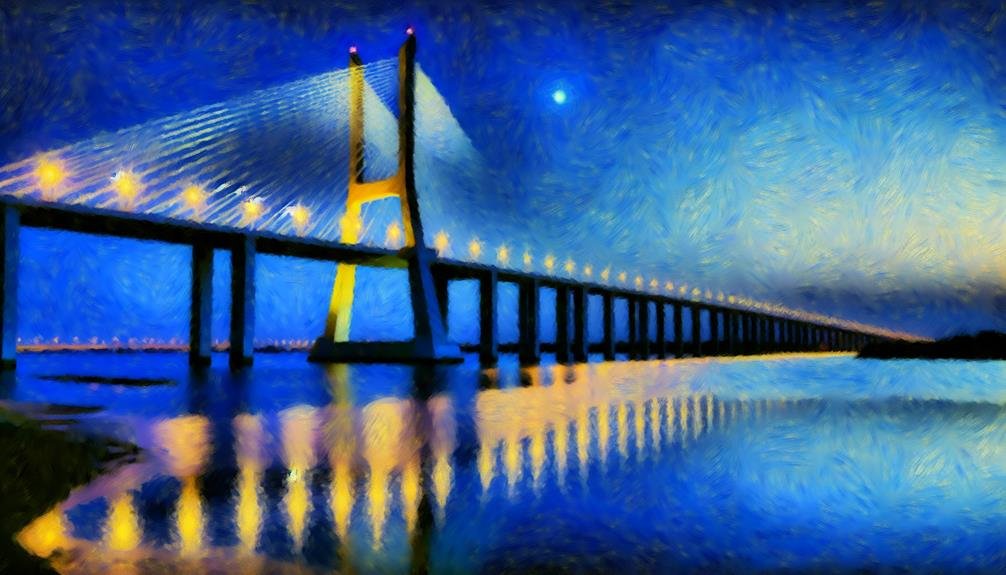Cable stayed bridges offer numerous advantages, such as striking visual appeal, versatility in design, and cost-effectiveness for medium-length spans. Their modern aesthetics can enhance urban environments and create iconic landmarks. However, they also present several challenges, including potential cable corrosion, higher initial construction costs, and complex maintenance requirements. These structures are vulnerable to wind-induced vibrations and require regular inspections to guarantee structural integrity. Despite these drawbacks, their practical applications in varied settings and efficient construction techniques make them a highly favored choice in contemporary bridge architecture. For a deeper understanding of their benefits and limitations, uncovering further details could be insightful.
Takeaways
- Cable stayed bridges offer visually appealing designs and can become iconic landmarks.
- They are cost-effective for medium-length spans and enhance urban aesthetics.
- These bridges face maintenance challenges, including regular inspections and potential cable replacements.
- Structural instability can occur in case of cable failure, and they are vulnerable to wind-induced vibrations.
- Despite higher initial construction costs, they use efficient techniques and pre-fabricated components to reduce project timelines.
Advantages of Cable Stayed Bridges
Cable-stayed bridges offer several advantages, including visually appealing designs that can become iconic landmarks. These structures are celebrated for their flexibility in design and construction, allowing engineers to implement various configurations tailored to specific site conditions and aesthetic preferences. The ability to span longer distances compared to other bridge types makes them particularly suitable for medium to long spans, providing both functionality and elegance.
One of the primary advantages of cable-stayed bridges is their cost-effectiveness for medium-length spans. These structures generally require less material than other bridge types, such as suspension bridges, which translates to reduced overall costs. Additionally, the design of cable-stayed bridges often leads to efficient construction, resulting in faster construction times and reduced labor expenses.
The combination of these factors makes cable-stayed bridges an attractive option for many projects. By incorporating fewer piers and offering a streamlined construction process, these bridges minimize environmental impact while maximizing economic and aesthetic benefits.
The compelling blend of cost-effectiveness, design flexibility, and rapid construction underscores the numerous advantages of cable-stayed bridges, solidifying their status as both practical and visually striking solutions in modern infrastructure.
Disadvantages of Cable Stayed Bridges

Despite their numerous advantages, these structures also present several challenges and drawbacks that need to be carefully considered. Cable-stayed bridges are particularly vulnerable to cable corrosion, which can have a notable impact on their structural integrity over time.
The initial construction costs of these bridges can be higher compared to other bridge types, primarily due to the complex cable systems required. This complexity not only increases initial expenses but also results in higher costs associated with maintenance challenges.
Maintaining cable-stayed bridges can be particularly demanding, as regular inspections and potential replacements of cables are necessary to guarantee safety and longevity. This ongoing requirement can be both logistically challenging and financially burdensome.
Additionally, cable-stayed bridges are not suitable for extremely long spans, as suspension bridges provide better support for such distances. This limitation can restrict their application in certain scenarios.
In terms of structural stability, cable-stayed bridges can be more susceptible to issues in the event of a cable failure. Such a failure can lead to significant structural instability, posing safety risks and necessitating immediate and potentially costly repairs.
Hence, while cable-stayed bridges offer many benefits, their disadvantages, including higher costs and maintenance challenges, need careful consideration.
Construction Efficiency
The construction efficiency of cable-stayed bridges is greatly enhanced by the use of pre-fabricated components and streamlined construction techniques. This approach greatly reduces the overall project timelines, making cable-stayed bridges an attractive option for medium-length spans.
By incorporating pre-fabricated components into the construction process, on-site activities are minimized, which not only accelerates the build but also enhances the precision and quality of the final structure. The design simplicity of cable-stayed bridges further contributes to their construction efficiency.
Unlike more complex bridge types, the straightforward design allows for easier assembly and fewer complications during the construction process. This simplicity translates to cost-effectiveness, as it reduces both material and labor requirements. Efficient construction techniques, such as using modular elements and advanced erection methods, help in achieving reduced labor costs and streamlined project management.
These methods make sure that each phase of the construction process is optimized for speed and accuracy. Consequently, the overall cost of constructing cable-stayed bridges is often lower compared to other bridge types, without compromising structural integrity or durability.
Design Versatility

Building on the construction efficiency, the design versatility of cable-stayed bridges offers numerous configuration options, such as varying tower heights and cable arrangements, to meet specific project needs. This flexibility allows for customized designs that can accommodate different traffic loads and environmental conditions, ensuring that the bridge performs at its best under varying circumstances. The ability to tailor these parameters makes cable-stayed bridges highly adaptable to a range of project requirements.
The design versatility also extends to aesthetic considerations, enabling engineers to create visually striking structures that enhance the surrounding landscape. This adaptability is further supported by the use of innovative construction methods and materials, which allow for the optimization of both functionality and cost-effectiveness. By leveraging modern engineering techniques, cable-stayed bridges can be constructed with greater precision and efficiency.
Moreover, the customization potential in cable-stayed bridges permits the incorporation of advanced technologies and sustainable materials, enhancing their longevity and environmental compatibility. These bridges can thus be designed to not only meet current demands but also to anticipate future needs, making them a forward-thinking choice in civil engineering.
Maintenance Challenges
Ensuring the longevity and safety of cable-stayed bridges necessitates regular and meticulous maintenance to address issues such as cable corrosion, pylon deterioration, and deck surface wear. These maintenance challenges are critical to preventing structural issues and ensuring the bridge's safe operation. Regular maintenance involves the use of specialized equipment and highly skilled personnel to inspect and repair the various components effectively.
Cable corrosion is a significant concern, often exacerbated by environmental factors such as moisture and temperature fluctuations. Pylon deterioration, which can result from prolonged exposure to harsh weather conditions, also demands timely intervention to avoid compromising the bridge's structural integrity. Additionally, deck surface wear from constant vehicular traffic requires ongoing monitoring and resurfacing efforts.
The complexity of these maintenance tasks is further heightened by the unique design of cable-stayed bridges, which necessitates precise and careful execution. Environmental factors like wind and precipitation can impede maintenance activities and accelerate deterioration.
Adopting a proactive maintenance strategy is essential to mitigate these challenges. By addressing these issues promptly and efficiently, it is possible to prolong the lifespan of cable-stayed bridges, ensuring they remain functional and safe for extended periods.
Popular Uses

While addressing maintenance challenges is essential for the longevity of cable-stayed bridges, their popular uses demonstrate their versatility and aesthetic appeal in various infrastructural applications. Cable-stayed bridges are frequently employed in the construction of roadways, pedestrian walkways, and light rail systems. This versatility makes them an attractive option for diverse traffic accommodations, effectively serving both vehicular and pedestrian needs.
One of the most prominent applications of cable-stayed bridges is in river crossings and estuaries, where their long-span capabilities are particularly advantageous. These structures are also a popular choice in urban areas, where their modern design adds significant aesthetic appeal to cityscapes. The visual elegance of cable-stayed bridges, combined with their engineering efficiency, has made them iconic features in many metropolitan settings.
Moreover, these bridges are often selected when a suspension bridge may not be economically feasible or when a cantilever bridge is not suitable for the required span. The ability of cable-stayed bridges to support long spans without the need for extensive anchoring systems further underscores their appeal in complex infrastructural projects. Thus, their widespread use underscores their adaptability and the advantages they offer in meeting contemporary engineering and design challenges.
Frequently Asked Questions
What Are the Advantages and Disadvantages of a Cable-Stayed Bridge?
Cable-stayed bridges offer advantages such as longer span lengths, aesthetic appeal, cost-effective construction, and design flexibility. However, they may face challenges in load distribution, maintenance requirements, weather resistance, seismic performance, and traffic capacity. Material efficiency is notable.
What Are the Pros and Cons of a Suspension Bridge?
Suspension bridges exhibit impressive span length and aesthetic appeal, with high load capacity and design flexibility. However, cost analysis reveals higher construction and maintenance costs, particularly due to wind resistance and seismic performance considerations, influenced by material choice and construction time.
What Are the Disadvantages of Cable Structure?
The disadvantages of cable structures include wind resistance, material fatigue, vibration issues, and cable corrosion. Additionally, their complex design, high costs, limited length, load distribution challenges, maintenance needs, and potential construction delays can impact their overall feasibility.
What Are the Pros and Cons of a Tied Arch Bridge?
Tied arch bridges offer excellent load distribution, aesthetic appeal, and material durability but involve high construction costs, complex maintenance requirements, and potential issues with structural stability. They provide good seismic performance, wind resistance, and significant visual impact over long span lengths.
Conclusion
Cable-stayed bridges offer significant advantages such as construction efficiency, design versatility, and aesthetic appeal, making them a popular choice for modern infrastructure projects. However, they also present challenges, including complex maintenance and higher initial costs compared to other bridge types.
While their benefits often outweigh the drawbacks, careful consideration of both pros and cons is essential for informed decision-making in bridge construction and engineering. Ultimately, their suitability depends on specific project requirements and environmental conditions.

